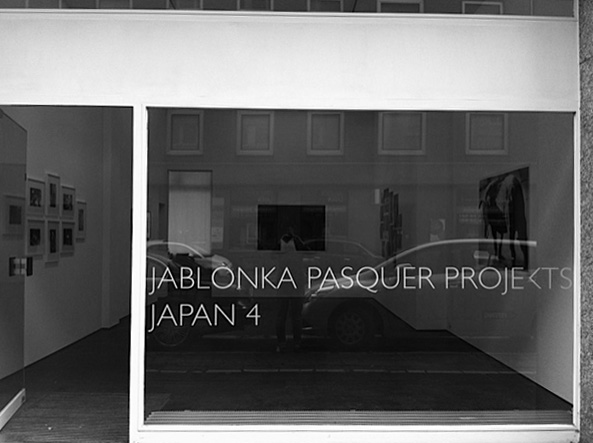JAPAN 4
Araki, Moriyama, Takanashi, Tomatsu
Jablonka Pasquer Projects
September 10th – November 11th, 2011
Galerie Priska Pasquer and Jablonka Galerie are delighted to be embarking on a new partnership for the 2011 autumn season. At Lindenstr. 19, Jablonka Pasquer Projects is presenting the exhibition:
Japan 4
Nobuyoshi Araki, Daido Moriyama, Yutaka Takanashi, Shomei Tomatsu
The exhibition centrally features four Japanese photographers whose work has significantly influenced the medium both within Japan and internationally.
Shomei Tomatsu (*1930) is the most important Japanese photographer of the latter half of the twentieth century. His photography series on the deep-reaching changes that have taken hold in Japanese society since the 1950s and his brilliant and powerful imagery make him the pre-eminent figure in Japanese art. The exhibition features a selection of the artist’s work from his central series, including ‘Bottle Melted and Deformed by Atomic Bomb Heat, Radiation and Fire, Nagasaki’ from the ‘Nagasaki 11:02’ series, as well as his ‘Eros’ work from the ‘OO! Shinjuku’ cover photography on the 1968 generation in Tokyo.
Nobuyoshi Araki, Daido Moriyama and Yutaka Takanashi are representatives of the ‘Provoke’ generation of artists that forged new frontiers and decisively broadened the scope of photography as a medium.
Yutaka Takanashi (*1935) and Daido Moriyama (*1938), co-founder and member of the ‘Provoke’ group (1968) respectively, radically broke from conventions in photography with their raw expressive style of ‘are, bore, boke’ (rough, blurred and out of focus). Like Shomei Tomatsu, they are driven by the search for identity in contemporary society, a society caught on the cusp between centuries-old traditions and modernity.
The search for the elemental in society and in individual existence leads Daido Moriyama to the grey fringes of Japanese life – to strip clubs, to the back rooms of cheap kabuki theatres and to bars catering to American soldiers, but first and foremost to the street and throughout rural Japan.
Yutaka Takanashi’s central theme is also change in Japan. In dark images, he describes a country that in vast areas has become a no man’s land between city and country devoid of any place for human beings except as consumers under the sway of American popular culture.
The revolutionary imagery of the ‘Provoke’ group continues to influence street photography in Japan and in the West to this day.
Nobuyoshi Araki (*1940), a contemporary of Takanashi and Moriyama, took a different path in both subject matter and imagery, one founded on an examination of Eros and Thanatos, the taboo depiction of sexuality in the mirror of ephemerality and death. His art flouts both societal and aesthetic rules, showing human sexuality unfiltered. Araki’s pictures range from subtle erotic studies to seemingly pornographic works while renouncing customary evaluations of of ‘good’ or ‘bad’ pictures.
In his work, he also unites two separate areas, such as personal and commission work, studio shots and street photography, private pictures and public. Nobuyoshi Araki’s work is in many respects marked by a radical transcendence of borders and unbridled excessiveness.
Galerie Priska Pasquer and Jablonka Galerie are delighted to be embarking on a new partnership for the 2011 autumn season. At Lindenstr. 19, Jablonka Pasquer Projects is presenting the exhibition:
Japan 4
Nobuyoshi Araki, Daido Moriyama, Yutaka Takanashi, Shomei Tomatsu
The exhibition centrally features four Japanese photographers whose work has significantly influenced the medium both within Japan and internationally.
Shomei Tomatsu (*1930) is the most important Japanese photographer of the latter half of the twentieth century. His photography series on the deep-reaching changes that have taken hold in Japanese society since the 1950s and his brilliant and powerful imagery make him the pre-eminent figure in Japanese art. The exhibition features a selection of the artist’s work from his central series, including ‘Bottle Melted and Deformed by Atomic Bomb Heat, Radiation and Fire, Nagasaki’ from the ‘Nagasaki 11:02’ series, as well as his ‘Eros’ work from the ‘OO! Shinjuku’ cover photography on the 1968 generation in Tokyo.
Nobuyoshi Araki, Daido Moriyama and Yutaka Takanashi are representatives of the ‘Provoke’ generation of artists that forged new frontiers and decisively broadened the scope of photography as a medium.
Yutaka Takanashi (*1935) and Daido Moriyama (*1938), co-founder and member of the ‘Provoke’ group (1968) respectively, radically broke from conventions in photography with their raw expressive style of ‘are, bore, boke’ (rough, blurred and out of focus). Like Shomei Tomatsu, they are driven by the search for identity in contemporary society, a society caught on the cusp between centuries-old traditions and modernity.
The search for the elemental in society and in individual existence leads Daido Moriyama to the grey fringes of Japanese life – to strip clubs, to the back rooms of cheap kabuki theatres and to bars catering to American soldiers, but first and foremost to the street and throughout rural Japan.
Yutaka Takanashi’s central theme is also change in Japan. In dark images, he describes a country that in vast areas has become a no man’s land between city and country devoid of any place for human beings except as consumers under the sway of American popular culture.
The revolutionary imagery of the ‘Provoke’ group continues to influence street photography in Japan and in the West to this day.
Nobuyoshi Araki (*1940), a contemporary of Takanashi and Moriyama, took a different path in both subject matter and imagery, one founded on an examination of Eros and Thanatos, the taboo depiction of sexuality in the mirror of ephemerality and death. His art flouts both societal and aesthetic rules, showing human sexuality unfiltered. Araki’s pictures range from subtle erotic studies to seemingly pornographic works while renouncing customary evaluations of of ‘good’ or ‘bad’ pictures.
In his work, he also unites two separate areas, such as personal and commission work, studio shots and street photography, private pictures and public. Nobuyoshi Araki’s work is in many respects marked by a radical transcendence of borders and unbridled excessiveness.









